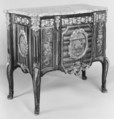Commode
Not on view
Son of the French cabinetmaker Antoine Foullet, who was specialized in the creation of clock cases, Pierre Antoine is best-known for his output of chests of drawers (commodes) executed in a transitional style. Even though the breakfront shape and the two drawers sans traverse (without a shelf in between) decorated with a central medallion are characteristic for his work, this particular example is smaller than most of Foullet’s commodes. While the curving cabriole legs and serpentine outline of the chest of drawers still show lingering influence of the Rococo style, the medallions, pendent musical trophies, and gilt-bronze mounts are clearly Neoclassical in nature. Since as a cabinetmaker, Foullet was not allowed to cast and chase the bronzes for his furniture, he must have collaborated closely with a member of the metalworkers’ guild since the outline of the apron mounts and the laurel-leaf and bow-knotted ribbon frames of the medallions are precisely outlined in the veneer. Typical for Foullet’s work is also the meticulous marquetry that he is thought to have executed himself given the fact that the marquetry of a secrétaire in the Wallace Collection, London, bears his signature.
Due to rights restrictions, this image cannot be enlarged, viewed at full screen, or downloaded.

